There can be many reasons for shoulder pain some of the most common are explained.
Fact : Anterior shoulder instability has been described in the medical literature since the time of Hippocrates
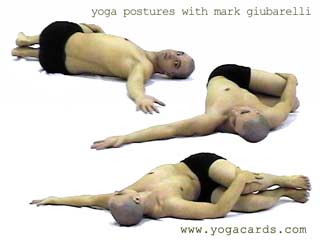 Posterior glenohumeral dislocations typically occur low and behind the glenoid beneath the acromion. Posterior dislocation often occurs when the arm is in flexion, adduction and internal rotation. Posterior glenohumeral instability is much less common than anterior instability in yoga and in general. Posterior shoulder dislocation is quite often miss-diagnosed.
Posterior glenohumeral dislocations typically occur low and behind the glenoid beneath the acromion. Posterior dislocation often occurs when the arm is in flexion, adduction and internal rotation. Posterior glenohumeral instability is much less common than anterior instability in yoga and in general. Posterior shoulder dislocation is quite often miss-diagnosed.
![]()
![]()
The anterior capsule is marked by thickenings of the glenohumeral ligaments but the posterior aspect of the joint capsule is thin in comparison. All the rubbing from the forward and downward forces of Chaturanga to Upward Dog often aggravate it in yoga practitioners.
Shoulder Pain Causes
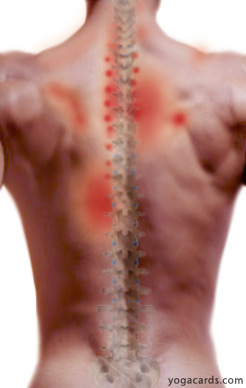 1. Tendinitis – Tendons are strong fibres that attach muscles to bones. Tendinitis is inflammation of a tendon and commonly affects shoulders. Tendons are quite often affected by repetitive motions. Switch up your transitions in yoga and try to use the muscles within the joints evenly. Many of the rotator cuff muscles can be affected by tendinitis one of the most commonly affected is the supraspinatus tendon. Occasionally a calcium deposit may form in the rotator cuff and cause acute inflammation of the tendon and bursa. This is called calcific tendinitis.
1. Tendinitis – Tendons are strong fibres that attach muscles to bones. Tendinitis is inflammation of a tendon and commonly affects shoulders. Tendons are quite often affected by repetitive motions. Switch up your transitions in yoga and try to use the muscles within the joints evenly. Many of the rotator cuff muscles can be affected by tendinitis one of the most commonly affected is the supraspinatus tendon. Occasionally a calcium deposit may form in the rotator cuff and cause acute inflammation of the tendon and bursa. This is called calcific tendinitis.
![]()
![]()
2. Bursitis – If the space between the rotator cuff and the bone above it is reduced, the rotator cuff tendons and the overlying bursa can become subjected to pressure leading to bursitis and tendinitis. (anterosuperior impingement syndrome, common in yoga, is classified as impingement in the under surface of the anterior third of the acromion).
![]()
![]()
3. Muscle injury – Usually a rotator cuff tear which is 1 of 4 muscles that surround and act on the shoulder.
![]()
![]()
4. Instability – The glenohumeral joint is a ball-and-socket joint. The motion that the glenohumeral joint provides is flexion, extension, abduction and adduction. Glenohumeral instability is the inability to maintain the humeral head into the socket (glenoid fossa).
![]()
![]()
5. Arthritis – The shoulder can be affected by many forms of arthritis. Osteoarthritis, rheumatoid arthritis, and traumatic arthritis are the most common types affecting the shoulder.
white space
![]()
6. Anterior dislocation often occurs when the anterior ligaments are overstretched or previously damaged and the arm is abducted and externally rotated.
white space
Shoulder Muscles & Ligaments
Here is a complete list of muscles and ligaments.
![]()
1. Subscapularis
3. Supraspinatus (commonly damaged muscle)
4. Teres minor
![]()
5. Superior Glenohumeral Ligament – This ligament arises anteriorly to the origin of the biceps tendon and inserts in the fovea capitis just superiorly of the lesser tuberosity.
![]()
6. Middle Glenohumeral Ligament – a ligament reinforcing the anterior of the glenohumeral joint begins at the anterior humeral neck medial to the lesser tuberosity and crosses the subscapularis tendon to attach to the neck of the glenoid immediately below the articular surface. it connects the humerus to the scapula.
![]()
7. Inferior Glenohumeral Ligament – a ligament reinforcing the anterior of the glenohumeral joint that connects the humerus to the scapula.
All of these ligaments are essential in anterior glenohumeral stability especially when the arm is arm abducted and externally rotated. This is done when the arms are brought beside the hips then raised up in a circular motion with the palms facing upwards. (Common motion in Yoga and sometimes preferred in Sun Salutations.)
![]()
Posterior glenohumeral dislocations typically occur low and behind the glenoid beneath the acromion. Posterior dislocation often occurs when the arm is in flexion, adduction and internal rotation.
![]()
Posterior glenohumeral instability is much less common than anterior instability in yoga and in general. Posterior shoulder dislocation is quite often miss-diagnosed.
![]()
9. Coracohumeral ligament – is a broad ligament, which strengthens the superior part of the capsule. The ligament arises from the coracoid process, passes towards the greater tubercle of the humerus and blends with supraspinatus. It stretches with external rotation but prevents too much external rotation. The anterior band stretches but prevents over extension with glenohumeral extension such as in Halasana with the hand clasped behind the back. The posterior band elongates when flexion occurs. This is done when the arms are raised overhead which is quite common in yoga. The posterior band limits too much glenohumeral flexion.
![]()
10. Superior Glenohumeral Ligament – This ligament arises anteriorly to the origin of the biceps tendon and inserts in the fovea capitis just superiorly of the lesser tuberosity.
![]()
Middle Glenohumeral Ligament – a ligament reinforcing the anterior of the glenohumeral joint begins at the anterior humeral neck medial to the lesser tuberosity and crosses the subscapularis tendon to attach to the neck of the glenoid immediately below the articular surface. it connects the humerus to the scapula.
![]()
Inferior Glenohumeral Ligament – a ligament reinforcing the anterior of the glenohumeral joint that connects the humerus to the scapula.
![]()
All of these ligaments are essential in anterior glenohumeral stability especially when the arm is arm abducted and externally rotated. This is done when the arms are brought beside the hips then raised up in a circular motion with the palms facing upwards. (Common motion in Yoga and sometimes preferred in Sun Salutations.)
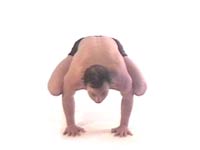
This yoga posture is easier on the shoulders when the elbows are slightly bent. Many times this yoga posture is seen with the arms straight.
Fact : Anterior shoulder instability has been described in the medical literature since the time of Hippocrates.
There are four ligaments that help stabilize and hold the glenohumeral joint. These ligaments are the coracohumeral ligament and 3 glenohumeral ligaments. Many of the transitions frequently done in yoga overstretch the anterior ligaments causing pain and inflammation in the front of teh shoulder.
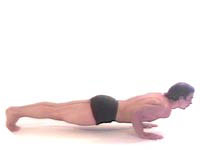
Chaturangasana
Instability is common in the anterior ligaments in the shoulder in yoga because of repetitive motions such as the repeated Chaturangasana transition into Upward Dog or Cobra.
![]()
A mild amount of instability will allow the shoulder to slip slightly out of socket, this is called a subluxation.
The knees can be brought down to reduce the force moving forward. Weight and force are really strong on the front, upper part of the shoulders.(Anterior, superior shoulder). Shift pressure towards the back of the palms to balance the force on the back (posterior) shoulder muscles and ligaments.
![]()
![]()
Rotator Cuff Tear
The Rotator Cuff is a name given to 4 muscles that surround the shoulder. They stabilize and mobilize the shoulder and arm. A rotator cuff injury can occur in 1 or more of these muscles in the shoulder.
![]()
Many rotator cuff tears do not require surgery and may even go unnoticed because no symptoms are present.
Feeling for tender areas can help determine the muscles that are affected.
![]()
The shoulder can also be tested for deformity or muscle weakness to reveal which muscles have been injured. You usually need another person for the test because they involve force being applied to an action. However they can be done against a wall or solid stationary object. Learn about the muscles and tests for the rotator cuff muscles by clicking the links to the muscles above.
![]()
![]()
If you are a yoga teacher and a student complains about shoulder pain give advice on the appropriate modifications that do not endanger the joint. Give a couple of suggestions for less impacting transitions and avoid high risk yoga postures that may aggravate the shoulder injury and lead to more shoulder pain. The more you know about the body and how it is affected by injuries the more you can help. The first rule of healing is, “do no harm”.
![]()
If you are a student and have a bad shoulder monitor your response. If shoulder pain occurs after class don’t be put off. Next time go with more care and perform modifications that help lower the pressure on the shoulder. If you only have a little shoulder pain yoga can help the healing process and keep the shoulder joint stable. Seek out good teachers if you suffer from chronic shoulder pain so that you can have the proper guidance and care.
![]()
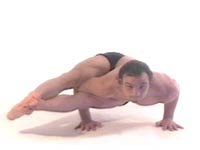
Yoga posture – Astavakrasana
This arm balance looks hard but it is actually one of the easier arm balancing postures in yoga. All of the arm balance yoga postures are hard on the anterior shoulder muscles, tendons and ligaments. Be careful monitor your response and if you are a teacher prevent students from rushing into these postures. (This occurs quite often in Crane pose shown below).
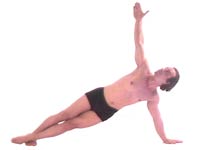
This pose is still a little controversial. There are positive benefits to strengthening the muscles around the shoulders without friction and some studies have shown positive responses in muscle balance but caution should be used when performing it. There are many causes of shoulder pain and more severe cases should approach challenging yoga postures with extreme caution.
![]()
![]()
Certain muscle instability in the shoulders should be treated with light exercises. In the side plank pose a lot of force falls on the shoulder. If the stabilizing muscles fatigue while holding too long the shoulder is in danger. Sometimes muscles are not functional due to a condition in the shoulder. Take great care not to create a secondary condition or any more damage. Impingement may be severely aggravated because of the heavy load on the joint.
![]()
Raising the hips higher creates even balance on the supporting shoulder and wrist. It looks more like a bow than a staff when performed with this modification.
Place the knee down as an easy option if your in a class or if your a yoga teacher and want to be safe with injured students.
Use ice packs to help with swelling and reduce pain.
![]()
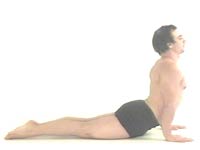
Recurrent instability typically produces symptoms when the arm is placed in similar positions to that which has caused the original injury. Observe the pains of the body. If an action causes pain in the shoulder modify it. If this only reduces the pain it may not be enough. The action may have to be avoided completely for healing to take place. Tearing of the labrum sometimes occurs with instability. Ligaments of the shoulder are attached to the socket at the labrum.
![]()
Posterior glenohumeral dislocations typically occur low and behind the glenoid beneath the acromion. Posterior dislocation often occurs when the arm is in flexion, adduction and internal rotation.
![]()
Posterior glenohumeral instability is much less common than anterior instability in yoga and in general. Posterior shoulder dislocation is quite often miss-diagnosed.
![]()
The anterior capsule is marked by thickenings of the glenohumeral ligaments but the posterior aspect of the joint capsule is thin in comparison.
